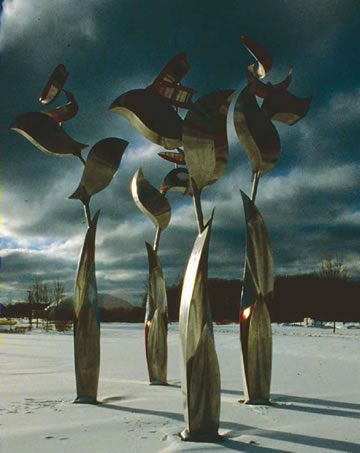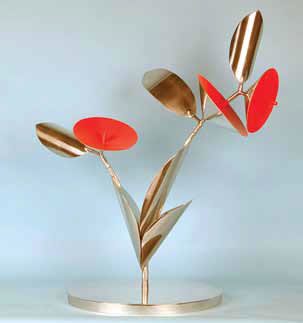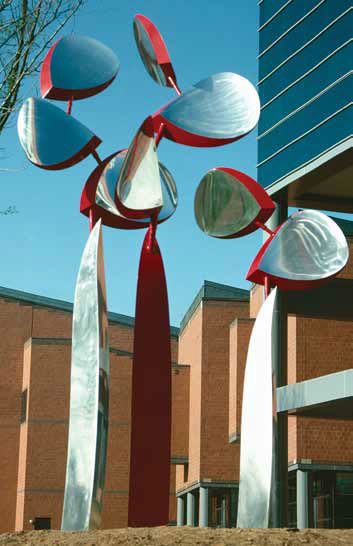By Adam Falik via Art Voices Magazine

In the more than half-a-century span of her career, Lin Emery has come to be recognized as one of America’s foremost kenetic sculpture artists. She has received world-wide commissions for some three dozen architectural-scale polished aluminum sculptures, each inspired by the forms and forces of nature. In 2012, Hudson Hills Press published a coffee-table tome detailing more than sixty years of work. It’s a beautiful book, heavy and dense with glossy photographs, one that attempts to encapsulate a lifetime of dedicated labor.
According to Lin Emery’s Wikipedia page, the artist was born in 1928, but I was too intimidated to ask for confirmation of this when she invited me into her New Orleans home one early fall day. Emery built this home, which is accessed by passing through her studio (the smaller of the two she owns and works from), in 1962. Neither Emery nor I were born Southerners, but she’s been here long enough to not be asked such indelicacies. Besides, her two assistants were waiting on her to continue working. Deadlines for multiple projects, in multiple countries, were pressing, and I didn’t want to risk the window of time she’d granted me by offending her. Whatever her precise age (which Emery might have told me outright; she seemed too intent for easy offense) was merely a matter of form, of time, and flesh. Emery’s creative force and work regiment felt more like someone if not in the prime of a career, than still at a point when one is utterly disinterested in such banal measurements: there was too much to be accomplished before breaking for lunch.
Adam Falik: The pieces you’re currently working on for the upcoming Odyssey Ball at the New Orleans Museum of Art, are they all new?
Lin Emery: They are mostly new, but I’ve been so distracted by a huge piece in [Louisiana State University], a suspended piece which is finished. The money for it is from the public art fund, which is assured, but they don’t have the money to hang it. So that’s a big problem. I’ve spent thousands of dollars on the motors and equipment to make it move, but they don’t have the funds to wire the motor, to put the whole thing together. And I’ve just gotten a bunch of images from China, where they’re making a big piece of mine. It’s for a sculpture park. They’re paying for the enlargement and also a $30,000 remuneration for me, as well as a round-trip ticket, but the work was so badly done I couldn’t put my signature to it. They started all over again and things are moving, but I’m not sure.
AF: Where in China?
LE: Wuhu. It’s a city a little west of Shanghai, near Nanjing.
AF: As an artist, have you reached a stage of comfort where you now work towards perfecting what you’ve spent a career mastering, or do you still feel your work evolving?
LE: They’re still evolving, very much so. I’ve got one new piece in the studio which I like a lot and which I’m going to enlarge. And I’m working on a new installation based on Isadora Duncan. None of the installation piece are sellable, but [Arthur Roger Gallery] often lets me show these, and I’ve shown a bunch at the Ogden Museum. They’re what I like doing.
AF: Is the human figure a new direction for you, or a return?
LE: I’ve done things based on dance before, and several pieces that were based on Japanese anime figures, manga figures. Human is just part of nature. All my work is related to trees and plants or water, and some of them have referenced people or dance. It’s just a broader context. I’m not sure how many people actually recognize the figurative, but it’s there.
AF: Why are you so attached to movement?
LE: Because everything I see—look at you, the trees: movement! The only sculpture teaching I ever had was one winter in Paris with Ossip [Zadkine]. He pointed out that Michelangelo’s late figures were made so that they turned faster than one could walk around them, the distortion felt when you moved around them. When I came back to the states, I was doing figures for churches all over the country. I always made them so they appeared to be moving like the Romanesque figures in churches in France, the robes that were twisted and feet that appeared to be moving.

AF: How would you describe the influence Ossip Zadkine had on your work?
LE: I was only there for seven or eight months. He took me on because he only had male students from the G.I. Bill and wanted to show them how to treat a total neophyte. Because I’d never done sculpture. He was very domineering. Women were below anything he could consider. I happen to have found his published diaries recently. Every day he wrote about how awful someone was, how disgraceful someone was being. [He was] very pugnacious. And that was a challenge to me.
AF: To step up?
LE: To succeed. Before that I had no idea what I wanted to do. I’d majored in religion and languages. I was in Paris because I wanted to be a correspondent and wrote for a scandal paper there. Theater was also on my docket. Summer stock in Mexico City, and then a year at Goodman Theater School with the Stanislavsky method. This was 1949-1950. But working with [Zadkine] that winter… I became a sculptor.
AF: Some people have called your work minimal, but I disagree. What I see is primordial.
LE: That’s a very good word. My sculptures are not pared down. There’s an essence.
AF: When you moved away from religious figures into large-scale abstractions, what do you think was happening in the art world that suddenly accepted and desired the type of work you were doing?
LE: I don’t think I ever thought about that. I was always more interested in technology. I learned how to weld, how to fabricate. I built a foundry with a friend and I loved to pour bronze. I never cared what came out of them; it was the fun of pouring. I came to the kinetic work very late. I’d been doing semi-abstractions, angles, and temples that were related to religion, and it was just by chance that I stumbled upon a kinetic idea. It was related to the Japanese idea of a sacred deer. Bamboo fills with water and drops. For many years I did water-activated pieces, huge pieces. There’s still one in Oklahoma City. I had so much trouble with pumping systems, [with] ice that froze the pieces.

AF: Did you enjoy that part of it, the mechanical?
LE: That’s always been my primary interest.
AF: Even more than the forms you were creating?
LE: Probably equal, but I loved working out the motor systems. After the water, I went to magnets. I did a 30-foot piece in Birmingham that worked with magnets. And there were problems there too. But I ended up with air, which is easier to manage, at least until there’s a hurricane.
AF: Is it fair to say that your enthusiasm for primal forms came out of Abstract Expressionism?
LE: It could be. I’ve had no art history, no art education. I don’t think I looked at very much other than antiquities and Romanesque sculpture. Antiquities still interest me.
AF: Are you working exclusively in aluminum now?
LE: Originally I only worked in bronze. Before [Hurricane] Katrina there was a company that was based in New Orleans that sold me wonderful sheet bronze, but they went out of business. When I have to do bronze now I get it from Colorado, which gets expensive. But New Orleans is a ship-building city. I can get aluminum anywhere, in any size.
AF: So it wasn’t a particular love of silver that has your current work looking like it does; it was an availability of metals.
LE: Yes.
AF: Do you feel okay about that?
LE: Well, that’s why I insist on polished silver because aluminum by itself is totally dead looking. Some of my pieces I’ve done a section on each element, bronze and aluminum, and as the piece moves the color reflects the other metals. It’s sort of an optical illusion so that you can’t tell where the color is. I like doing that.
AF: You’ve had a long career working within the New Orleans art scene. What are the most significant changes you’ve seen?
LE: I’m pleased with what’s happening down on St. Claude. I was one of the early people working at the [Contemporary Art Center], and you could do anything then, it didn’t matter what. That’s what got me started on installation pieces. I was able to do water pieces, whatever, but the CAC has changed. It has become so regimented. I’m pleased with St. Claude but I don’t think the area has reached what we had at the CAC. It’s too constricted. The spaces are too small. We had that big building and we could do anything we wanted.
AF: Do you still work every day?
LE: Of course. Don’t you?
